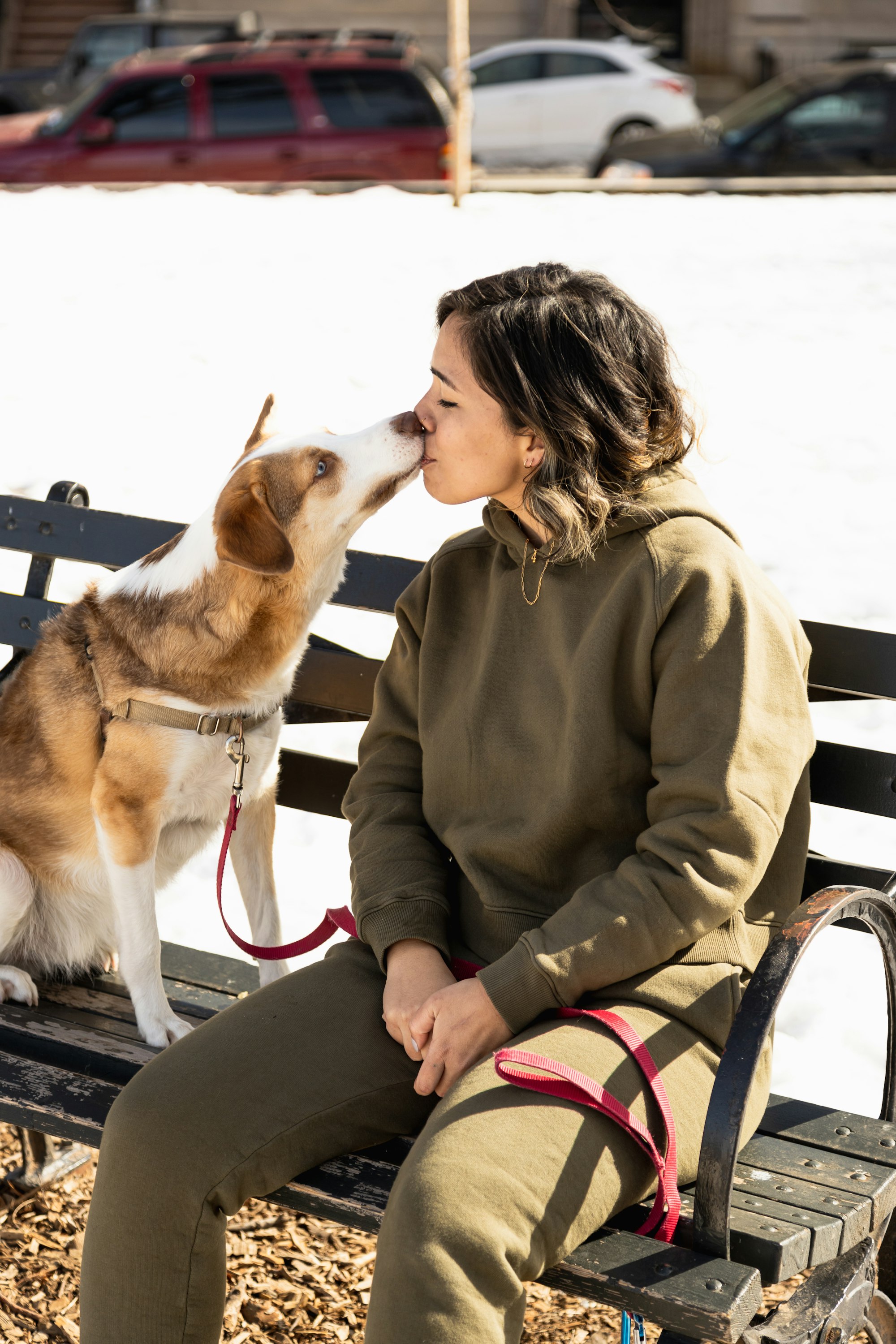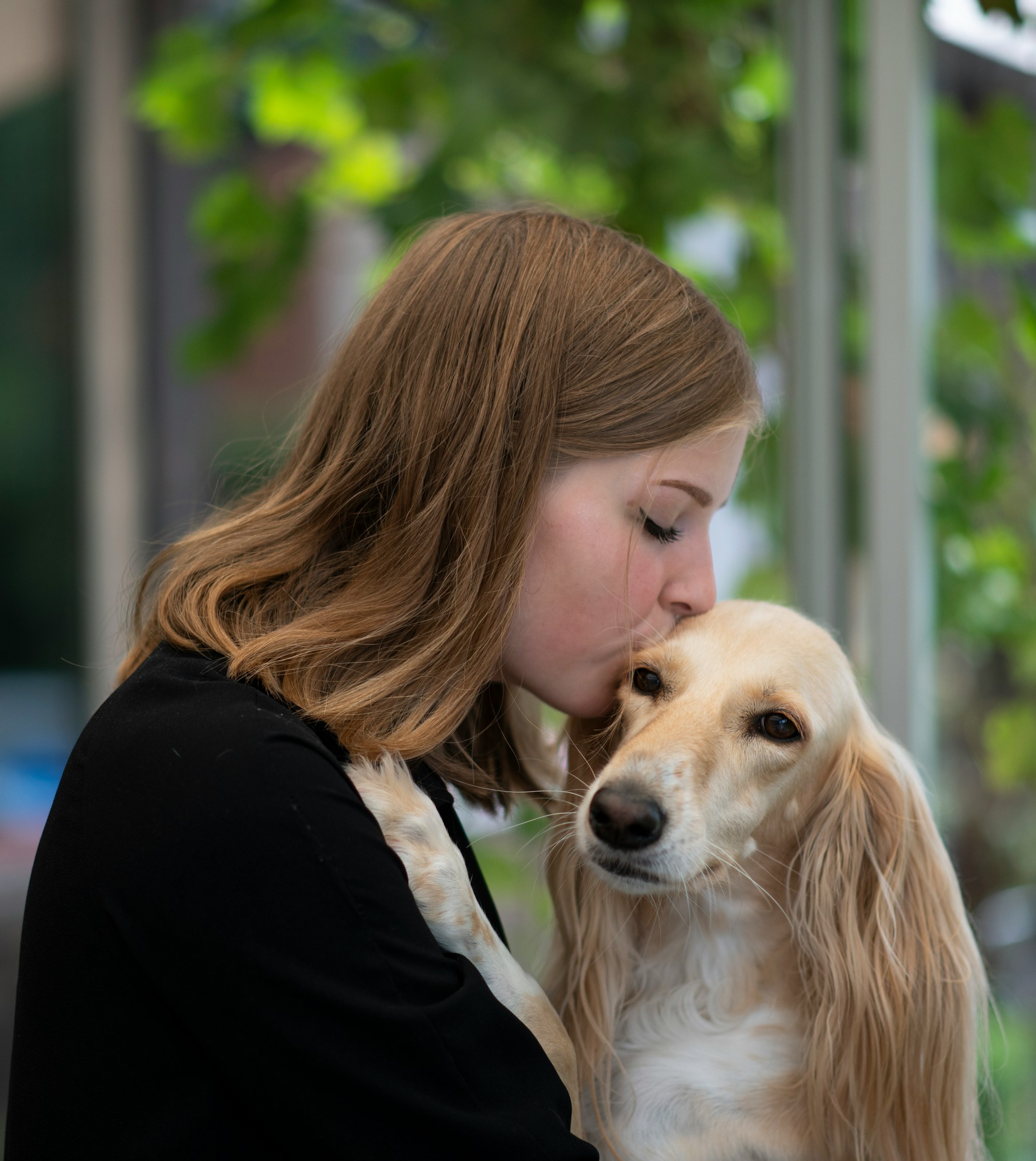Dogs have long been cherished companions, often considered members of the family. In showing affection to these loyal friends, many of us instinctively turn to human expressions of love, such as hugging and kissing. These gestures, laden with emotion and tenderness in human interactions, are translated into our interactions with dogs, with kisses often serving as a universal sign of affection.

However, this raises an intriguing question: How do dogs perceive these expressions of affection? Given that canines communicate primarily through body language and non-verbal cues, the human act of kissing is not something naturally mirrored in their behavior. This discrepancy leads us to ponder whether dogs understand the sentiment behind a kiss or if they simply learn to associate this human gesture with the positive emotions and attention it usually accompanies.
Kisses From a Dog’s Perspective
Have you ever kissed a puppy? Or an older dog who has never been kissed before? Your innocent sign of affection may have been ignored or even not well received, especially by the older dog.
Why is that?
Let’s think about kisses from a dog’s perspective for a second. Kissing is not a natural behavior for them. Physically they can’t pucker up and plant a kiss of their own so it certainly isn’t instinctive for them.
Of course, dogs will lick and touch one another to show affection but they tend to approach one another from the side, not head-on. The action of a human face suddenly coming close to them is strange and can be perceived as an intention to bite.
What makes matters worse is that many owners will hug the dog at the same time, thus unintentionally removing the dog’s ability to escape. More than one person has received a nip in the face from a dog who was simply defending himself from a perceived threat.
Can Dogs Learn to Like Kisses?
But some dogs seem to enjoy being kissed by their owners. They come running to greet their owners when they arrive and snuggle up, ready to receive the shower of affection they know is coming.
That’s the key idea here — the shower of affection they know is coming.
Dogs may not naturally understand kisses as affection, but they can certainly learn that’s what they are. When you snuggle and pet your dog while showering them with kisses and talking to them in a little baby voice, they learn to associate kisses with love.
And if there’s anything dogs love, it’s love.
However, keep in mind that not all dogs will be happy with this arrangement. Some may be totally content to accept your kisses as affection, whereas others may find the action too strange to get used to.
This is dependent in part on the dog’s personality, but a big part of it is how they’ve been socialized. If they receive kisses from the time they are small puppies, they are more likely to tolerate or even love your kisses.
However, introducing kisses to older dogs, especially rescues, can be much more challenging — even dangerous. It feels uncomfortable or perhaps even scary to them. Any dog that has not had a positive history with humans will absolutely not welcome a face, particularly the mouth, coming close to them.
The Nature of Canine Communication
Dogs are adept communicators, utilizing a rich tapestry of body language and non-verbal cues to express their emotions, desires, and intentions. Unlike humans, who rely heavily on spoken language, dogs convey messages through physical gestures, facial expressions, tail positioning, and vocal sounds. A wagging tail, for instance, often signifies happiness or excitement, while a tucked tail can indicate fear or submission. Ears perked up may show interest, whereas flattened ears might signal anxiety or aggression. These subtle and not-so-subtle cues form the backbone of canine communication, allowing dogs to interact effectively with each other and their human companions.
In contrast, human expressions of affection, such as hugging and kissing, do not naturally align with canine communication methods. While humans view these gestures as warm and comforting, dogs might find them confusing or even threatening due to their instinctual reading of body language. For example, a hug, which involves wrapping arms around another's body, can be perceived by a dog as a dominant or restraining gesture, potentially inducing stress rather than comfort. This fundamental difference in communication styles underscores the need for humans to adapt their expressions of affection in ways that are more aligned with canine understanding and comfort levels.

Human Expressions of Affection: A Canine Perspective
From a canine perspective, human expressions of affection, particularly kissing, may be met with a mix of curiosity, confusion, or even discomfort. In the dog world, a face coming directly towards another's can be seen as a threatening gesture, rather than an affectionate one. When humans lean in for a kiss, dogs might interpret this action through the lens of their instinctual language, potentially perceiving it as a challenge or invasion of personal space. This misinterpretation can lead to visible signs of anxiety in dogs, such as turning their head away, licking their lips, or yawning — all calming signals in canine communication indicating discomfort or an attempt to defuse what they perceive as a tense situation.
Moreover, the act of hugging, which often accompanies kissing, can further exacerbate a dog's discomfort. In dog language, being embraced or restrained can trigger a fight or flight response, as it restricts their ability to move freely and escape if they feel the need. While some dogs may learn to associate kisses with positive experiences and affection from their owners, it's crucial to observe and respect each dog's individual response to these human expressions of love, ensuring that our intentions to show affection do not inadvertently cause stress or fear.
Do Dogs Understand Kisses as Affection?
While dogs may not innately understand the human gesture of kissing as an expression of affection, they are highly capable of learning to associate it with positive experiences. This learning often occurs through a process known as classical conditioning, where dogs begin to connect the act of receiving kisses with subsequent rewards, such as treats, gentle petting, or verbal praise. Over time, these positive reinforcements can help a dog interpret a kiss not as a threat, but as a precursor to enjoyable experiences, thereby associating it with affection and comfort.
The key to this association lies in consistent and positive interactions. When a dog consistently receives positive feedback in conjunction with kisses, they start to recognize the pattern. The kiss becomes a signal for the forthcoming positive interaction, much like the sound of a treat container being opened. It's important, however, to be mindful of the dog's comfort level and personal boundaries during this process.
Not all dogs will become comfortable with kisses, even with positive associations, and their individual preferences should be respected. Observing the dog's body language and reactions is crucial to ensure that the conditioning process is a positive experience for the dog, fostering a deeper bond between the dog and its owner.

Individual Variability in Dogs' Reactions to Kisses
Dogs, much like humans, exhibit a wide range of personalities and temperaments, leading to varied responses to human gestures of affection such as kisses. These reactions are deeply influenced by factors such as the dog's breed, individual personality, past experiences, and level of socialization. For instance, a dog raised in a warm, affectionate environment from puppyhood may be more receptive to kisses and close physical contact, viewing them as normal aspects of their interaction with humans.
Conversely, rescue dogs, who may have had traumatic experiences with humans in the past, might find such close encounters intimidating or even threatening. The sudden approach of a human face can trigger defensive mechanisms in these dogs, leading to avoidance behaviors or, in more extreme cases, aggressive responses. Their perception of kisses can be significantly different, associating them with dominance or confrontation rather than affection.
Moreover, dogs that have not been adequately socialized from a young age might also struggle to understand and accept kisses. The lack of early exposure to a variety of people and situations can result in a less adaptable adult dog, unsure of how to interpret and respond to human expressions of love. Recognizing and respecting these individual differences is crucial for fostering positive human-dog interactions and ensuring the well-being of both parties.
Interpreting a Dog's Response to Kisses
Interpreting a dog's response to kisses and cuddles requires a keen understanding of canine body language. Signs of comfort in a dog may include a relaxed posture, soft eyes, and a gently wagging tail, indicating they feel safe and content with the affection being shown. Some dogs might lean into the kiss or cuddle, seeking more contact, or even nuzzle their owner in return, clearly enjoying the interaction.
Conversely, signs of distress can be more subtle but are crucial for owners to recognize. A dog feeling uncomfortable might turn their head away, avoid eye contact, or display lip licking and yawning as signs of anxiety. More pronounced signs include tensing up, trying to move away, or even growling softly as a clear indication of discomfort. These signs suggest that the dog is not receptive to kisses or cuddles at that moment and needs space.
Owners can ensure their dog's comfort with physical affection by observing these cues closely and responding accordingly. It's important to start with gentle affection and gradually increase the intensity, always watching for the dog's response. If a dog shows any signs of discomfort, it's best to pause and give them some space. Respecting these boundaries not only ensures the dog's well-being but also strengthens the trust and bond between the dog and its owner.
Alternative Ways to Show Affection to Dogs
Showing affection to dogs in ways that align with their natural communication styles can greatly enhance the bond between pets and their owners. Instead of relying solely on human expressions like kissing, consider alternative methods that dogs are more likely to understand and appreciate. Gentle petting, particularly in areas that dogs tend to enjoy like the base of the tail, behind the ears, or under the chin, can be a soothing and enjoyable form of affection for many dogs. It's important to observe the dog's reaction to ensure they are comfortable with the type and location of petting.
Engaging in play is another effective way to show love, catering to a dog's instinctual need for physical activity and mental stimulation. Activities like fetch, tug-of-war, or agility exercises not only strengthen the emotional connection but also contribute to the dog's physical well-being. Verbal praise, delivered in a warm, enthusiastic tone, can also be a powerful form of affection, particularly when combined with positive reinforcement training techniques.
Offering treats or favorite toys can be a tangible expression of love, especially when used as rewards for good behavior or as part of a training routine. These methods of showing affection not only foster a positive and loving relationship but also respect the dog's natural instincts and communication preferences.
How Dogs Show Affection
Some people take the kissing thing one step further and teach their dogs to “kiss” them back. Since dogs can’t pucker up, this means a nice sloppy lick.
But dogs have lots of other ways they like to show affection. It’s good for you to understand the signs so you can feel your pup’s genuine affection, even if they don’t particularly like your kisses.
- Physical proximity or contact (nuzzling, snuggling, lying near you, leaning against you)
- Excitement to see you (jumping, wiggling, racing around, etc)
- Tail wagging
- Following you around
- Sleeping near you
- Licking you
- Sharing their toys with you
Through these behaviors and more, your dog makes it clear to you that he likes you.
Educating Dog Owners on Respectful Interactions
Educating dog owners about respectful interactions is pivotal for nurturing a healthy and mutually beneficial relationship with their pets. Central to this is the recognition and respect of a dog's personal space and comfort levels. Just as humans have varying thresholds for physical contact and proximity, so do dogs. Owners must learn to read their dog's body language and signals, which communicate their readiness or reluctance for interaction.
Observation is key. By paying close attention to a dog's responses to different forms of affection and interaction, owners can discern what their pet prefers and what makes them uncomfortable. Some dogs may revel in close cuddles and frequent petting, while others might value their personal space more, showing appreciation for affection in less intrusive ways.
Adapting interactions to suit each dog's unique preferences not only ensures the dog's well-being but also deepens the bond between dog and owner. Respectful interactions, based on understanding and adapting to a dog's signals, create a foundation of trust and comfort, allowing the relationship to thrive.

Showing Affection to Your Pup in Ways they Understand
You can make your affection clear to your pup by reciprocating some of these behaviors, minus the tail wagging, of course.
You can also:
- Pet them
- Offer treats
- Scratch their bellies or ears
- Play fetch
- Take them for walks or runs
All of these actions clearly speak love to your dog. Their natural excitement when you do them shows how well-received these signs of affection are.
And, if you have accustomed your dog to kisses, they’ll love those too!
Conclusion
In conclusion, while dogs may not innately comprehend human kisses as expressions of affection, they can learn to associate them with positive experiences. However, individual dogs' reactions to kisses vary widely, influenced by their personality, past experiences, and socialization. It's essential for dog owners to understand and respect these individual preferences, observing their pet's body language to ensure comfort with such interactions. Embracing alternative ways of showing affection that align with canine communication can enhance the bond between dogs and their owners. Ultimately, a relationship grounded in mutual understanding and respect ensures a happy and healthy coexistence.






